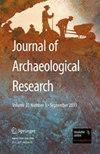大美索不达米亚地区国家形成的不同轨迹:来自阿尔斯兰特佩(土耳其)的观点
IF 4.1
1区 历史学
Q1 ANTHROPOLOGY
引用次数: 0
摘要
在土耳其马拉蒂亚的阿斯兰特佩(Arslantepe)进行的长期发掘揭示了公元前四千年在一个非城市遗址中发展起来的一个早熟的宫殿体系,该体系拥有不朽的建筑群、复杂的官僚体系以及强大的经济和政治权力集中。本文从比较的角度重新考虑了大美索不达米亚最早国家的主要特征和组织结构。通过研究等级制度和不平等关系出现的社会和经济基础、城市化的动态和程度以及意识形态的作用,我强调了三大核心地区--美索不达米亚南部、美索不达米亚北部和幼发拉底河上游流域--国家形成和结果的共同方面和多样化轨迹。本文章由计算机程序翻译,如有差异,请以英文原文为准。
Different Trajectories in State Formation in Greater Mesopotamia: A View from Arslantepe (Turkey)
Long-term excavations at Arslantepe, Malatya (Turkey), have revealed the development, in the fourth millennium BC, of a precocious palatial system with a monumental building complex, sophisticated bureaucracy, and a strong centralization of economic and political power in a nonurban site. This paper reconsiders, in comparative terms, the main features and organization of the earliest states in Greater Mesopotamia. By looking at the social and economic foundations of the emergence of hierarchies and unequal relations, the dynamics and degrees of urbanization, and the role of ideology, I highlight the common aspects and the diversified trajectories of state formation and outcomes in three main core regions—southern Mesopotamia, northern Mesopotamia, and Upper Euphrates valley.
求助全文
通过发布文献求助,成功后即可免费获取论文全文。
去求助
来源期刊

Journal of Archaeological Research
Multiple-
CiteScore
10.20
自引率
7.90%
发文量
9
期刊介绍:
Journal of Archaeological Research publishes the most recent international research summaries on a broad range of topics and geographical areas. The articles are intended to present the current state-of-the-discipline in regard to a particular geographic area or specific research topic or theme. This authoritative review journal improves access to the growing body of information and literature through the publication of original critical articles, each in a 25-40 page format.2-Year Impact Factor: 4.056 (2017) 5-Year Impact Factor: 4.512 (2017)2 out of 85 on the Anthropology listIncluded in the European Reference Index for the Humanities (ERIH) PLUS The European Reference Index for the Humanities and the Social Sciences (ERIH PLUS) was created and developed by European researchers under the coordination of the Standing Committee for the Humanities (SCH) of the European Science Foundation (ESF). https://dbh.nsd.uib.no/publiseringskanaler/erihplus/about/indexSCImago Journal and Country Rank (SJR) 2018: 1.7102 out of 263 on the Archeology (Arts and Humanities) list3 out of 254 on the Archeology list2 out of 131 on the General Arts and Humanities listSJR is a measure of the journal’s relative impact in its field, based on its number of citations and number of articles per publication year.Source Normalised Impact per Paper (SNIP) 2018: 2.112The SNIP measures contextual citation impact by weighting citations based on the total number of citations in a subject field. The impact of a single citation is given higher value in subject areas where citations are less likely, and vice versa.CiteScore 2018: 3.86Rated ''A'' in the Australian Research Council Humanities and Creative Arts Journal List. For more information, visit: http://www.arc.gov.au/era/journal_list.htm
SCImago Journal and Country Rank (SJR) 2011 1.227 Archeology 1 out of 96 Archeology (Arts and Humanities) 1 out of 59 Arts and Humanities (miscellaneous) 1 out of 243
 求助内容:
求助内容: 应助结果提醒方式:
应助结果提醒方式:


